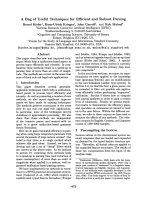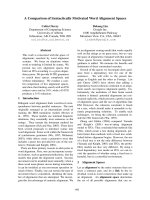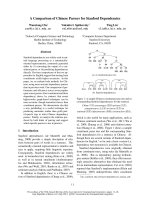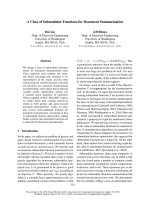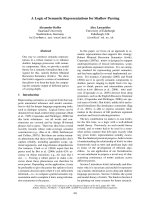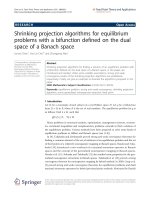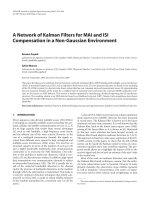Báo cáo toán học: "A strengthening of Brooks’ Theorem for line graphs" doc
Bạn đang xem bản rút gọn của tài liệu. Xem và tải ngay bản đầy đủ của tài liệu tại đây (93.58 KB, 7 trang )
A strengthening of Brooks’ Theorem for line graphs
Landon Rabern
314 Euclid Way, Boulder CO, U.S.A.
Submitted: Feb 10, 2010; Accepted: Jun 20, 2011; Published: Jul 15, 2011
Mathematics Subject Classification: 05C15
Abstract
We prove that if G is the line graph of a multigraph, th en the chromatic number
χ(G) of G is at most max
ω(G),
7∆(G)+10
8
where ω(G) and ∆(G) are the clique
number and the maximum degree of G, respectively. Thus Brooks’ Theorem holds
for line graphs of multigraphs in much stronger form. Using similar methods we
then prove that if G is th e line graph of a multigraph with χ(G) ≥ ∆(G) ≥ 9, then G
contains a clique on ∆(G) vertices. Thus the Borodin-Kostochka Conjecture holds
for line graphs of multigraphs.
1 Introduction
We define nonstandard notation when it is first used. For standard notation a nd termi-
nology see [2]. The clique number of a graph is a trivial lower bound on t he chromatic
number. Brooks’ Theorem gives a sufficient condition for this lower bound to be achieved.
Theorem 1 (Brooks [4]). If G is a graph with ∆(G) ≥ 3 and χ(G) ≥ ∆(G) + 1, then
ω(G) = χ(G).
We give a much weaker condition for the lower bound to be achieved when G is the
line graph o f a multigraph.
Theorem 2. If G is the line graph of a multigraph with χ(G) >
7∆(G)+10
8
, then ω (G ) =
χ(G).
Combining this with an upper bound o f Molloy a nd R eed [16] on the fractional chro-
matic number and partia l results on the Goldberg Conjecture [8] yields yet another proof
of the following result (see [14] for the original proof and [17] for further r emarks and a
different proof).
Theorem 3 (King, Reed and Vetta [14]). If G is the line graph of a multigraph, then
χ(G) ≤
ω(G)+∆(G)+1
2
.
the electronic journal of combinatorics 18 (2011), #p145 1
Reed [18] conjectures tha t the bound χ(G) ≤
ω(G)+∆(G)+1
2
holds for all graphs G.
For further information about Reed’s conjecture, see King’s thesis [11] and King and
Reed’s proof of the conjecture for quasi-line gr aphs [13]. Back in t he 1970’s Borodin and
Kostochka [3] conjectured the following.
Conjecture 4 (Borodin and Kostochka [3]). If G is a graph with χ(G) ≥ ∆(G) ≥ 9, then
G contains a K
∆(G)
.
In [19] Reed proved this conjecture for ∆(G) ≥ 10
14
. The only known connected
counterexample for the ∆(G) = 8 case is the line graph of a 5-cycle where each edge
has multiplicity 3 (that is, G = L(3 · C
5
)). We prove that there are no counterexamples
that are the line graph of a multigraph f or ∆(G) ≥ 9. This is tight since the above
counterexample for ∆(G) = 8 is a line graph of a multigraph.
Theorem 5. If G is the line graph of a multigraph with χ(G) ≥ ∆(G) ≥ 9, then G
contains a K
∆(G)
.
In [7], Dhurandhar proved the Borodin-Kostochka Conjecture for a superset of line
graphs of sim p l e graphs defined by excluding the claw, K
5
− e and another gra ph D as
induced subgraphs. Kierstead and Schmerl [10] improved this by removing the need to
exclude D. We note that there is no containment relation between the line graphs of
multigraphs and the class of graphs containing no induced claw and no induced K
5
− e.
2 The proofs
Lemma 6. Fix k ≥ 0. Let H be a multigraph and put G = L(H). Suppose χ(G) =
∆(G) + 1 − k. If xy ∈ E(H) is critical and µ(xy) ≥ 2k + 2, then xy is contained i n a
χ(G)-clique in G.
Proof. Let xy ∈ E(H) be a critical edge with µ(xy) ≥ 2k + 2. Let A be the set of all
edges incident with both x and y. L et B be the set of edges incident with either x or
y but not both. Then, in G, A is a clique joined t o B and B is the complement of a
bipartite graph. Put F = G[A ∪ B]. Since xy is critical, we have a χ(G) − 1 coloring of
G − F . Viewed as a partial χ(G) − 1 coloring of G this leaves a list assignment L on F
with |L(v)| = χ(G) − 1 − (d
G
(v) − d
F
(v)) = d
F
(v) − k + ∆(G) − d
G
(v) for each v ∈ V (F ).
Put j = k + d
G
(xy) − ∆(G).
Let M be a maximum matching in the complement of B. First suppose |M| ≤ j.
Then, since B is perfect, ω(B) = χ(B) and we have
ω(F ) = ω(A) + ω(B) = |A| + χ(B)
≥ |A| + |B| − j = d
G
(xy) + 1 − j
= ∆(G) + 1 − k = χ(G).
Thus xy is contained in a χ(G)-clique in G.
the electronic journal of combinatorics 18 (2011), #p145 2
Hence we may assume that |M| ≥ j +1. Let {{ x
1
, y
1
}, . . . , {x
j+1
, y
j+1
}} be a matching
in the complement of B. Then, for each 1 ≤ i ≤ j + 1 we have
|L(x
i
)| + |L(y
i
)| ≥ d
F
(x
i
) + d
F
(y
i
) − 2k
≥ |B| − 2 + 2|A| − 2k
= d
G
(xy) + |A| − 2k − 1
≥ d
G
(xy) + 1.
Here the second inequality follows since α(B) ≤ 2 and the last since |A| = µ(xy) ≥ 2k +2.
Since the lists together contain at most χ(G) − 1 = ∆(G) − k colors we see that for each
i,
|L(x
i
) ∩ L(y
i
)| ≥ |L(x
i
)| + |L(y
i
)| − (∆(G) − k)
≥ d
G
(xy) + 1 − ∆(G) + k
= j + 1.
Thus we may color the vertices in the pairs {x
1
, y
1
}, . . . , {x
j+1
, y
j+1
} from L using one
color for each pair. Since |A| ≥ k + 1 we can extend this to a coloring of B from L by
coloring greedily. But each vertex in A has j+1 colors used twice on its neighborhood, thus
each vertex in A is left with a list of size at least d
A
(v)−k+∆(G)−d
G
(v)+j+1 = d
A
(v)+1.
Hence we can complete the (χ(G) − 1)-coloring to all of F by coloring greedily. This
contradiction completes the proof.
Theorem 7. If G is the line graph o f a multigraph H and G is vertex critical , then
χ(G) ≤ max
ω(G), ∆(G) + 1 −
µ(H) − 1
2
.
Proof. Let G be the line graph of a multigraph H such that G is vertex critical. Say
χ(G) = ∆(G) + 1 − k. Suppose χ(G ) > ω(G). Since G is vertex critical, every edge in H
is critical. Hence, by Lemma 6, µ(H) ≤ 2k + 1. That is, µ(H) ≤ 2(∆(G) + 1 − χ(G) ) + 1.
The theorem fo llows.
This upper bound is tight. To see this, let H
t
= t · C
5
(i.e. C
5
where each edge has
multiplicity t) and put G
t
= L(H
t
). As Catlin [6] showed, for odd t we have χ(G
t
) =
5t+1
2
,
∆(G
t
) = 3t − 1, and ω(G
t
) = 2t. Since µ(H
t
) = t, the upper bound is achieved.
We need the following lemma which is a consequence of the fan equation (see [1, 5, 8, 9]).
Lemma 8. Let G be the line graph of a multigraph H. Suppose G is vertex critical with
χ(G) > ∆(H). Then, for a ny x ∈ V (H) there exist z
1
, z
2
∈ N
H
(x) such that z
1
= z
2
and
• χ(G) ≤ d
H
(z
1
) + µ(xz
1
),
• 2χ(G ) ≤ d
H
(z
1
) + µ(xz
1
) + d
H
(z
2
) + µ(xz
2
).
the electronic journal of combinatorics 18 (2011), #p145 3
Lemma 9. Let G be the line graph of a multigraph H. If G is vertex critical with
χ(G) > ∆(H), then
χ(G) ≤
3µ(H) + ∆(G) + 1
2
.
Proof. Let x ∈ V (H) with d
H
(x) = ∆(H). By Lemma 8 we have z ∈ N
H
(x) such that
χ(G) ≤ d
H
(z) + µ(xz). Hence
∆(G) + 1 ≥ d
H
(x) + d
H
(z) − µ(xz) ≥ d
H
(x) + χ(G) − 2µ(xz).
Which gives
χ(G) ≤ ∆(G) + 1 − ∆(H) + 2µ(H).
Adding Vizing’s inequality χ(G) ≤ ∆(H) + µ(H) gives the desired result.
Combining this with Theorem 7 we get the following upper bound.
Theorem 10. If G is the line graph of a multigraph, then
χ(G) ≤ max
ω(G),
7∆(G) + 10
8
.
Proof. Suppose not and choose a counterexample G with the minimum number of vertices.
Say G = L(H). Plainly, G is vertex critical. Suppose χ(G) > ω(G). By Theorem 7 we
have
χ(G) ≤ ∆(G) + 1 −
µ(H) − 1
2
.
By Lemma 9 we have
χ(G) ≤
3µ(H) + ∆(G) + 1
2
.
Adding three times the first inequality to the second gives
4χ(G) ≤
7
2
(∆(G) + 1) +
3
2
.
The theorem fo llows.
Corollary 11. If G is the line graph of a multigraph with χ(G) ≥ ∆(G) ≥ 1 1 , then G
contains a K
∆(G)
.
With a little more care we can get the 11 down to 9. Our analysis will be simpler
if we can inductively reduce to the ∆(G) = 9 case. This reduction is easy using the
following lemma from [17] (it also follows from a lemma of Kostochka in [15]). Recently,
King [12] improved the ω(G) ≥
3
4
(∆(G) + 1) condition to the weakest possible condition
ω(G) >
2
3
(∆(G) + 1).
Lemma 12. If G is a graph with ω(G) ≥
3
4
(∆(G) + 1), then G has an independent set I
such that ω(G − I) < ω (G ).
the electronic journal of combinatorics 18 (2011), #p145 4
Proof of Theorem 5. Suppose the theorem is false and choose a counterexample F mini-
mizing ∆(F ). By Brooks’ Theorem we must have χ(F ) = ∆(F ). Supp ose ∆(F ) ≥ 10. By
Lemma 12, we have an independent set I in F such tha t ω(F − I) < ω(F ). Expand I to
a maximal independent set M and put T = F − M. Then χ(T ) ≥ ∆(F ) − 1 and ∆(T ) ≤
∆(F )−1. Hence, by minimality of ∆(F ) and Brooks’ Theorem, ω(F ) ≥ ω(T )+1 ≥ ∆(F ).
This is a contradiction, hence χ(F ) = ∆(F ) = 9.
Let G be a 9-critical subgraph of F . Then G is a line graph of a multigraph. If
∆(G) ≤ 8, then G is K
9
by Brooks’ Theorem giving a contradiction. Hence ∆(G) ≥ 9.
Since G is critical, it is also connected.
Let H be such that G = L(H). Then by Lemma 6 and Lemma 9 we know that
µ(H) = 3. Let x ∈ V (H) with d
H
(x) = ∆(H) . Then we have z
1
, z
2
∈ N
H
(x) as in
Lemma 8. This gives
9 ≤ d
H
(z
1
) + µ(xz
1
), (1)
18 ≤ d
H
(z
1
) + µ(xz
1
) + d
H
(z
2
) + µ(xz
2
). (2)
In addition, we have for i = 1, 2,
9 ≥ d
H
(x) + d
H
(z
i
) − µ(xz
i
) − 1 = ∆(H) + d
H
(z
i
) − µ(xz
i
) − 1.
Thus,
∆(H) ≤ 2µ(xz
1
) + 1 ≤ 7, (3)
∆(H) ≤ µ(xz
1
) + µ(xz
2
) + 1. (4)
Now, let ab ∈ E(H) with µ(ab) = 3. Then, since G is vertex critical, we have
8 = ∆(G) − 1 ≤ d
H
(a) + d
H
(b) − µ(ab) − 1 ≤ 2∆(H) − 4. Thus ∆(H) ≥ 6. Hence we
have 6 ≤ ∆(H) ≤ 7. Thus, by (3), we must have µ(xz
1
) = 3.
First, suppose ∆(H) = 7. Then, by (4) we have µ(xz
2
) = 3. Let y be the other
neighbor of x. Then µ(xy) = 1 and thus d
H
(x) + d
H
(y) − 2 ≤ 9. That gives d
H
(y) ≤ 4.
Then we have vertices w
1
, w
2
∈ N
H
(y) guaranteed by Lemma 8. Note that x ∈ { w
1
, w
2
}.
Now 4 ≥ d
H
(y) ≥ 1 + µ ( yw
1
) + µ(yw
2
). Thus µ(yw
1
) + µ(yw
2
) ≤ 3. This gives d
H
(w
1
) +
d
H
(w
2
) ≥ 2∆(G) − 3 = 15 contradicting ∆(H) ≤ 7.
Thus we must have ∆(H) = 6. By (1) we have d
H
(z
1
) = 6. Then, applying (2) gives
µ(xz
2
) = 3 a nd d
H
(z
2
) = 6. Since x was an arbitrary vertex of maximum degree and
H is connected we conclude that G = L(3 · C
n
) for some n ≥ 4. But no such graph is
9-chromatic by Brooks’ Theorem.
3 Some conjectures
The graphs G
t
= L(t · C
5
) discussed above show that the following upper bounds would
be tight. Creating a counterexample would require some new construction technique that
might lead to more counterexamples to Borodin-Kostochka for ∆ = 8.
the electronic journal of combinatorics 18 (2011), #p145 5
Conjecture 13. If G is the line graph of a multigraph, then
χ(G) ≤ max
ω(G),
5∆(G) + 8
6
.
This would follow if the 3µ(H) in Lemma 9 could be improved to 2µ(H)+1. The following
weaker statement would imply Conjecture 13 in a similar fashion.
Conjecture 14. If G is the line graph of a multigraph H, then
χ(G) ≤ max
ω(G),
∆(G) + 2
2
+ µ(H)
.
Since we a lways have ∆(H) ≥
∆(G)+2
2
, this can be seen as an improvement of Vizing’s
Theorem for graphs with ω(G) < χ(G).
Acknowledgments
Thanks to anonymous referee for helping to improve the readability of the paper.
References
[1] L.D . Andersen, On edge-col orings of graphs, Math. Scand 40 (1977), 161–175.
[2] J.A. Bondy and U.S.R. Murty, Graph theory, Springer, 2008.
[3] O.V. Borodin and A.V. Kostochka, On an upper bound of a graph’s chromatic num-
ber, d e pending on the graph’ s degree and density, Journal of Combinatorial Theory,
Series B 23 ( 1977), no. 2-3, 247–250.
[4] R.L. Brooks, On colouring the nodes of a network, Mathematical Proceedings of the
Cambridge Philosophical Society, vol. 37, Cambridge Univ Press, 1941, pp. 194–197.
[5] D. Cariolaro, On fans in multigrap hs, Journal of Graph Theory 51 (2006), no. 4,
301–318.
[6] P.A. Catlin, Haj´os graph-coloring conjecture: variations and counterexample s , J.
Combin. Theory Ser. B 26 ( 1979), no. 2, 268–274.
[7] M. Dhurandhar, Improvement on Brooks’ chromatic bound for a class of g raphs,
Discrete Mathematics 42 ( 1982), no. 1, 51–56.
[8] L.M. Favrholdt, M. Stiebitz, and B. Toft, Graph edge colouring: Vizing’s theo rem
and goldberg’s conjecture, (2006).
[9] M.K. Goldberg, Edge-coloring of multigraphs: Recoloring technique, Journal of Graph
Theory 8 (1984), no. 1, 123–137.
[10] H.A. Kierstead and J.H. Schmerl, The chromatic number of graphs which induce
neither K
1,3
nor K
5
− e, Discrete mathematics 58 (1986), no. 3, 253–262 .
the electronic journal of combinatorics 18 (2011), #p145 6
[11] A. King, Claw-free graphs and two conjectures on omega, Delta, and ch i , Ph.D. thesis,
McGill University, 2009 .
[12] A.D. King, Hitting all m aximum cliques with a stable set using lopsided independent
transv e rs als, Journal of Graph Theory (In Press, 2010).
[13] A.D. King and B.A. Reed, Bounding χ in terms of ω and ∆ for quasi- line graph s,
Journal of Graph Theory 59 (2008), no. 3, 215–228.
[14] A.D. King, B.A. Reed, and A. Vetta, An upper bound for the chromatic number of
line graphs, European Journal of Combinatorics 28 (2007), no. 8, 2182–2187.
[15] A.V. Kostochka, Degree, density, and chromatic number, Metody Diskret. Anal. 35
(1980), 45–70.
[16] M.S. Molloy a nd B.A. Reed, Graph colouring and the probabilistic method, Springer
Verlag, 2002.
[17] L. Rabern, On hitting all maximum cliques with an independent set, Journal of Graph
Theory 66 (2011), no. 1, 32–37.
[18] B. Reed, ω, ∆, and χ, Journal of Gra ph Theory 27 (1998), no. 4, 177–21 2.
[19] , A strengthening of Brooks’ theorem, Journal of Combinatorial Theory, Series
B 76 (1999), no. 2, 136–149.
the electronic journal of combinatorics 18 (2011), #p145 7
